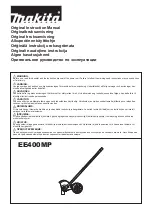
11
Subject to change without notice
of the capacitor. It may be assumed that this is negligible for
frequencies
>
40 Hz.
Considering the foregoing you may measure DC signals of up to
600 V or pure AC signals of up to 1200 V
PP
with a HZ200 probe.
Probes with higher attenuation like HZ53 100:1 allow to measure
DC up to 1200 V and pure AC of up to 2400 V
PP
. (Please note
the derating for higher frequencies, consult the HZ53 manual).
Stressing a 10:1 probe beyond its ratings will risk destruction of
the capacitor bridging the input resistor with possible ensuing
damage of the scope input!
In case the residual ripple of a high voltage is to be measured a
high voltage capacitor may be inserted in front of a 10:1 probe, it
will take most of the voltage as the value of the probe’s internal
capacitor is very low, 22 to 68 nF will be suffi cient.
If the input selector is switched to Ground the reference trace
on the screen may be positioned at graticule center or else-
where.
DC and AC components of an input signal
The dashed curve shows an AC signal symmetrical to zero. If
there is a DC component the peak value will be DC + AC peak.
Timing relationships
In most cases repetitive signals must be measured. The repe-
tition frequency of a signal is equal to the number of periods
per second. Depending on the TIME/DIV setting one or more
periods or part of a period of the signal may be displayed. The
time base settings will be indicated on the readout in s/cm,
ms/cm, μs/cm and ns/cm (1 cm is the equivalent of 1 div. on
the crt graticule). Also the cursors may be used to measure the
frequency or the period.
Without cursor the cycle duration can be determined by multi-
plying the length (cm) with the (calibrated) time coeffi cient. The
reciprocal value is the frequency.
If portions of the signal are to be measured use delayed sweep
(analog mode) or zoom (digital mode) or the magnifi er x 10. Use
the HORIZONTAL positioning control to shift the portion to be
zoomed into the screen center.
Pulse signals are characterized by their rise and fall times
which are measured between the 10 % and 90 % portions. The
following example uses the internal graticule of the crt, but also
the cursors may be used for measurement.
Measurement:
– Adjust the rising portion of the signal to 5 cm.
– Position the rising portion symmetrically to the graticule
centre line, using both Y and X positioning controls.
– Notice the intersections of the signal with the 10 and 90 %
lines and project these points to the centre line in order to
read the time difference.
In the example it was 1.6 cm at 5 ns/cm equals 8 ns rise time.
When measuring very short rise times coming close to the scope
rise time it is necessary to subtract the scope’s (and if used the
probe’s) rise times geometrically from the rise time as seen on
the screen. The true signal rise time will become:
t
tot
is the rise time seen, t
osc
is the scope’s own rise time (1.75
ns with the HM2008), t
t
is the rise time of the probe, e.g. 2 ns.
If the signal’s rise time is
>
22 ns, the rise times of scope and
probe may be neglected.
For the measurement of rise times it is not necessary to proceed
as outlined above. Rise times may be measured anywhere on
the screen. It is mandatory that the rising portion of the signal
be measured in full and that the 10 to 90 % are observed. In
case of signals with over- or undershoot the 0 and 100 % levels
are those of the horizontal portions of the signal, i.e. the over-
resp. undershoots must be disregarded for rise and fall time
measurements. Also, glitches will be disregarded. If signals
are very distorted, however, rise and fall time measurements
may be of no value.
For most amplifi ers, even if their pulse behaviour is far from
ideal, the following relationship holds:
350
350
t
a
= —— B = ——
B
t
a
tr/ns = 350/Bandwidth/MHz
Connection of signals
In most cases pressing the AUTOSET button will yield a satisf-
actory display (see AUTOSET). The following relates to special
cases where manual settings will be advisable. For a description
of controls refer to ”Controls and Readout“.
STOP
Take care when connecting unknown signals to the
inputs!
It is recommended to use probes whenever possible. Without
a probe start with the attenuator set to its 20 V/cm position.
If the trace disappears the signal amplitude may be too large
overdriving the vertical amplifi er or/and its DC content may be
too high. Reduce the sensitivity until the trace will reappear
B a s i c s i g n a l m e a s u r e m e n t
t
a
=
8
2
- 2.3
2
- 2
2
= 7,5 ns
t
a
=
t
tot
2
– t
osc
2
– t
t
2
voltage
peak
AC
DC
DC
AC
DC + AC
peak
= 400 V
max
5 cm
t
tot
100%
90%
10%
0%












































